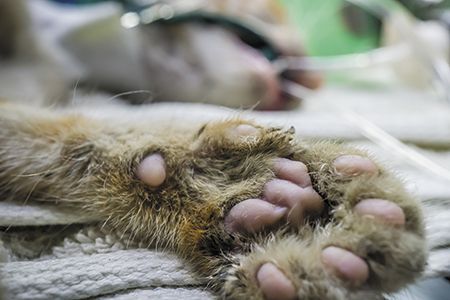AAFP releases first anesthesia guidelines catered to cats
A panel of feline experts fashioned the guidelines to ensure a safer session for cats undergoing surgery.

She's counting on you. (Shutterstock.com)The American Association of Feline Practitioners (AAFP) has released the profession's first feline-specific anesthesia guidelines. Because of their unique physiology and small size, cats undergoing anesthesia are at a relatively greater risk of complications and mortality than many other species, states a release from the association. Empirical evidence shows that cats undergoing anesthesia have a higher mortality rate compared with dogs.1,2
According to the AAFP release, a standardized, evidence-based approach for administering anesthesia helps ensure a patient's safe and predictable perioperative response and recovery. The guidelines address specific ways of avoiding complications associated with monitoring, airway management, fluid therapy and recovery. Additionally, they discuss perianesthetic anxiety and stress, perianesthetic monitoring by physical and electronic means, the role of underlying diseases such as hypertrophic cardiomyopathy, the correct use of anesthesia equipment, and total injectable anesthesia.
“The overarching purpose of the AAFP Anesthesia Guidelines is to make anesthesia and sedation safer for the feline patient,” says Heather O'Steen, CEO of the AAFP, in the release. “We are committed to improving the health and welfare of all cats and providing this resource to veterinary teams is an important milestone.”
The guidelines, created by an expert panel, include tables, charts, algorithms and other information designed to minimize risks associated with anesthesia. The associated client brochure helps owners understand what anesthesia is, what to expect, how to properly prepare their cats for a procedure and how to care for them during recovery.
The guidelines co-chairs-Susan M. Gogolski, DVM, PMP, DABVP (canine/feline), and Sheilah A. Robertson, BVMS (Hons), PhD, DACVAA, DECVAA, DACAW, DECAWBM (WSEL), MRCVS-say in a joint statement, “By proactively developing an individualized anesthetic plan that considers the uniqueness of each feline patient and recognizing that ‘one size does not fit all,' the experience for the cat can be improved and the outcome successful. It is our hope that these Guidelines will become the practice's go-to resource and each team member will have a new awareness of all the tools and techniques available to them.”
The guidelines have been endorsed by the International Society of Feline Medicine. Access the guidelines, supplemental resource and client brochure at www.catvets.com/guidelines/practice-guidelines/anesthesia-guidelines.
References
1. Dyson DH, Maxie MG, Schnurr D. Morbidity and mortality associated with anesthetic management in small animal veterinary practice in Ontario. J Am Anim Hosp Assoc 1998;34:325-335.
2. Brodbelt DC, Pfeiffer DU, Young LE, et al. Risk factors for anaesthetic-related death in cats: results from the confidential enquiry into perioperative small animal fatalities (CEPSAF). Br J Anaesth 2007;99:617-623.